Russian Dwarf Hamster Facts – Top 17 Asked Questions…Answered
Welcome to our question and answer section where most Russian Dwarf Hamster facts are revealed. In this section you will learn a lot about your Russian Dwarfs, so grab a pen and paper or alternatively bookmark this page.
Before we start, does anyone know why this play toy has become the most popular buy of 2018?
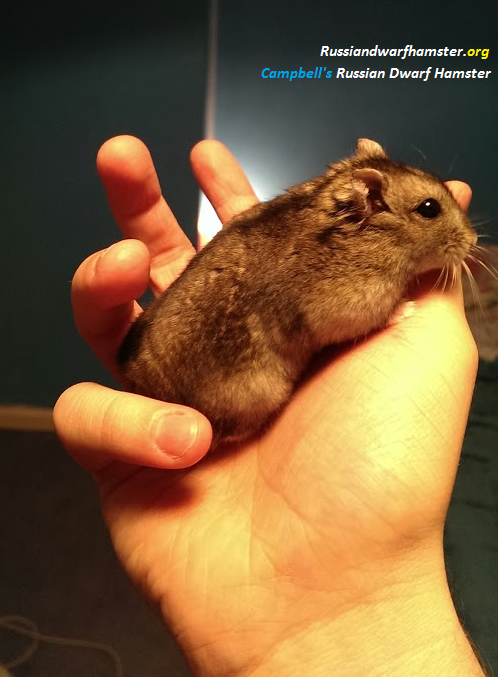
What Are Russian Dwarf Hamsters?
Russian dwarf hamsters are a species of hamster in the genus Phodopus. It is native to China, Kazakhstan, Mongolia and Russian Federation. There are two types of Russian Dwarf:
- Campbell’s Russian Dwarf Hamster
- Russian Winter White Dwarf Hamster
Campbell’s are more popular kept as pets by children and adults because most pet stores have this type. They are easy to tame and friendly towards house mates and can live together under certain circumstances. Please see Russian Dwarf Hamsters Fighting – What To Do
Campbell’s are generally dark brown, has a narrow stripe on its back and grey fur on its underside (stomach). See picture.
Russian Winter White dwarf hamsters are very similar to Cambell’s but for one distinctive feature. Winter whites turn white in the winter (when the days get shorter) and grow white fur. The reason for this is to camouflage in the winter snow and to hide from overhead predators like eagles and owls in the wild. Although same size, lifespan and behavior, Russian winter whites are more rare and there real name is Djungarian hamsters.
Both are considered as Russian Dwarf Hamsters.

Russian Winter White Dwarf Hamster
What is the difference between Dwarf hamsters and Syrian hamsters
Dwarf hamsters are similar to Syrian (Gold Hamster) hamster and larger breeds by characteristics and behavior. Although they both enjoy similar activities, dwarf hamsters are considerably smaller and easier to care for. A Russian dwarf hamsters average full size is roughly 80 mm in length and a Syrian is roughly 140 – 180mm in length.
Although most hamster breeds can not live in pairs, Russian dwarfs can live with a fellow gender* (please see Can Russian Dwarfs Live Together).
Russian Dwarfs are easier to look after, cheaper to keep and require less space compared to a Syrian. Dwarf hamsters are not as good pets for children under the age of 7 though and do not live as long as Syrian hamsters. Please see Russian Dwarf Lifespan for more.
How you Should Handle a Russian Dwarf Hamster?
Russian Dwarfs should always be picked up from underneath (as if you would scoop water with two hands). This is the best way to let your hamster get used to you and best for taming Russian dwarf hamsters. Please see our video below.
In the early weeks of keeping a Russian Dwarf Hamster you should apply these tips above in the video. This will help your hamster become used to you and realize that you do not cause a threat to them. Remember that you are a giant to them and they are easily scared.
Are dwarf hamsters good pets?
Russian Dwarf Hamsters are a type of dwarf hamster and come in handful of colors. They are very friendly and sociable with others that are introduced properly or from the same litter.
Dwarf hamsters are great pets to have because they are easy to tame, easy to care for, very lovable and inexpensive to keep. However dwarf hamsters are not great pets for children of the age 0-8 and are easily frightened, which can lead to biting or nibbling.
How Long do Russian Dwarf Hamsters Live
The lifespan of a Russian dwarf is roughly 16-24 months. This can vary between hamsters.
Are Russian Dwarf Hamsters Nocturnal?
Yes. They come out at night when most of their primary predators are sleeping. Advice for this ; move their cage into another room only at night to prevent being woken up.
Campbell’s are more active at night compared to winter whites. Winter whites can be active in the day for short periods
Also they are more likely to bite or nibble in the day if they are scared or woken up. When woken and frightened they can feel threatened and bite.
Tame hamsters generally don’t do this but if suddenly cooped out of their cage half asleep, they may bite.
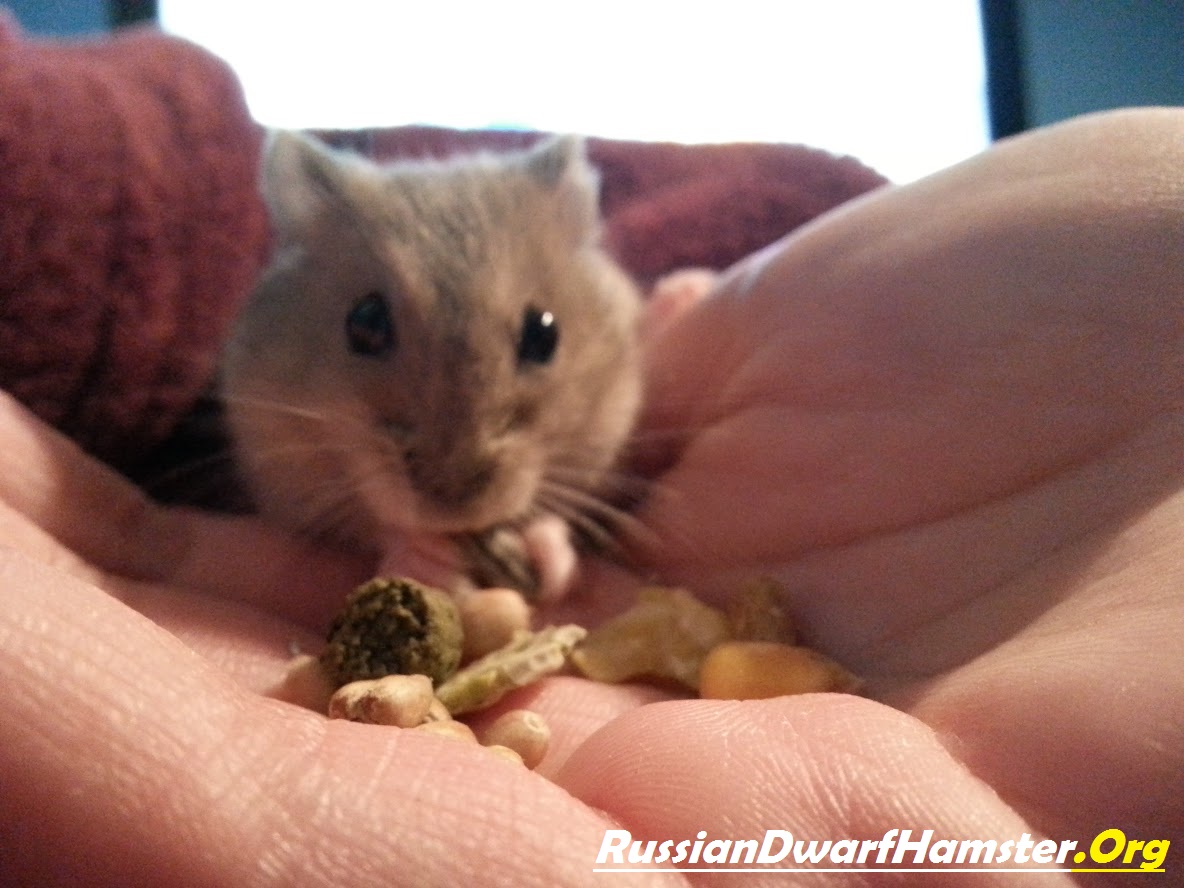
Best food for russian dwarf hamsters
Best food for Russian Dwarf Hamsters & Can Russian Dwarfs Live Together?
When choosing the best food for Russian dwarf hamsters there is a wide variety. A great example of good food is a mixture of dried fruit, nuts and muesli.
They also love fruits and vegetables once a week. See which fruits and vegetables your hamster loves in our care/diet section.
Russian Dwarfs are very sociable and enjoy the company of others. However many Russian Dwarfs hamsters prefer to live on their own and this is normal. How are we to know what they prefer?
Dwarf Hamsters are very territorial (after 2-3 months) and generally will not except a new visitor to live with them if they were brought up alone from 3-4 weeks old (it is their territory and they will fight for it). On the other hand they can live side by side with one or two of their brothers or sisters from the same mother (if brought up with them from an early age). Every Russian dwarf hamster is different.
Females have a higher chance of living together than males because males have scent glands used for marking territory. Because males are territorial they generally fight however females do not have scent glands so can live together and considered more peaceful to one another.
Males at an age of 6-8 weeks will play fight. However this may turn into fighting for dominance.
This can be due to food, space and territory. If two males are kept within a small cage and or do not have their own food bowls, toys and bedding they may fight to the death. The main reasons for Russian Dwarfs fighting are due to food, space and territory. If your hamsters are climbing the cage bars and knawing, see How to stop dwarf hamsters biting the bars in 3 steps.
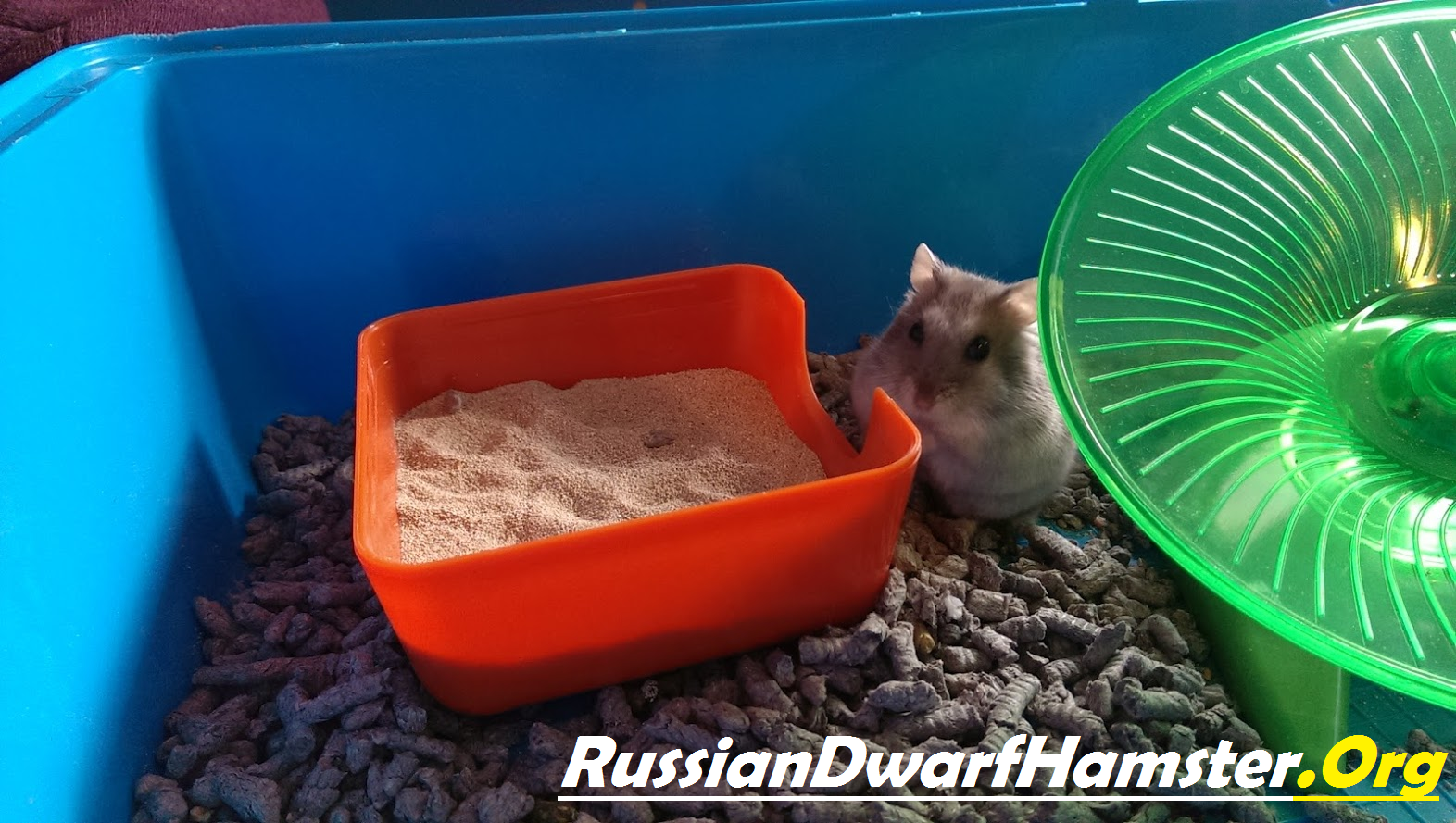
The more space the better. Although small, they must always have a big cage to run and play.
Females do not have scent glands so can live together. Although in many cases both genders live together as long as plenty of space is available.
Can I keep a male and female Russian dwarf together? – They will breed and if the father isn’t split within 24 hours of birth they will breed again. The father will breed with the siblings at around 3 weeks, it is better to remove the male before the babies arrive. In the wild a male and a female will get together to breed then go their separate ways.
Male and female Russian Dwarf Hamsters that are kept together from a young age (3 weeks of age and above) will mate and have babies. It is not advised to breed dwarf hamsters.
Compared to other dwarf hamsters species, Russian father hamsters become very good fathers and help, protect and look after the young and the mother. This includes cleaning, bringing food and protecting if danger is present.
If your hamster has suddenly had babies or you are unaware of what gender your hamster is please see – Learn How to Care for Russian Dwarf babies by clicking here.
When having two Russian Dwarfs together in the same cage you should always be prepared to split them up, even if you never have to. Check out the Top 10 best dwarf hamster cages!
What do Russian Dwarf Hamsters like?
Hamsters love to play, run and create nests to hide. 5 things Russian Dwarf Hamsters love:
1. Flying Saucer – This is a non fixed wheel that is slanted to create an easy to use/run wheel. On Amazon here.
2. Wooden Accessories- Wooden toys are great for hamsters. They are cheap, ready made and great for their teeth. We recommend wooden houses, ladders and bendable play toys over plastic accessories.See our TOP 10 Accessories They LOVE.
3. A Big Cage with tubes, space and at least 2 floors/platforms. Watch our Video review for the Ferplast Duna cage.
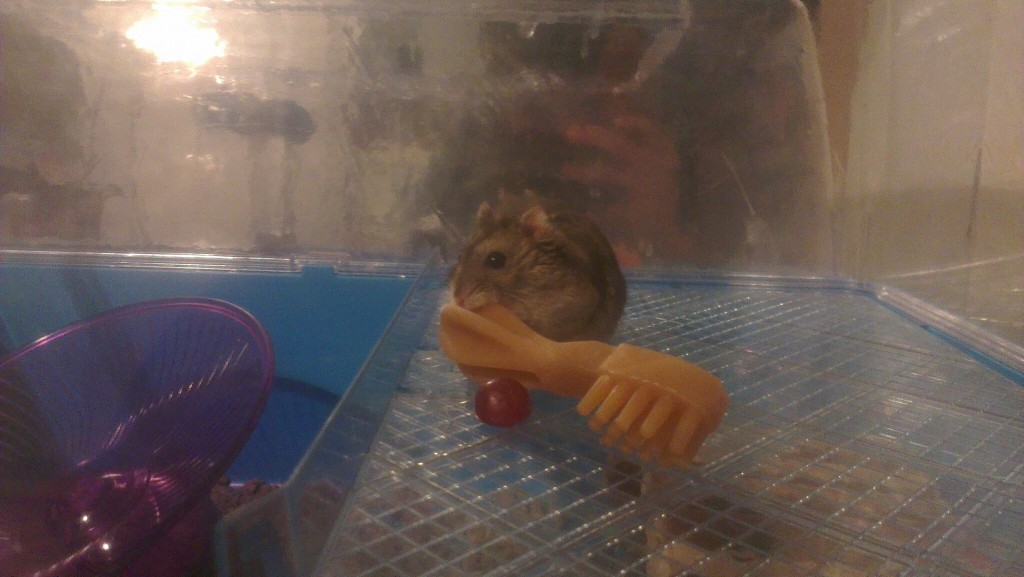
4. “Chewies” – Did you know that a hamsters teeth never stop growing? Chewies are great for their teeth and provide a tasty chew for your hamster whilst preventing their teeth overgrowing.
5. An exercise ball – This is a great way to keep your hamster fit and healthy. Click here to see how it works.
How Much Do hamsters Cost
Roughly between $10-30 or 10-20 GBPs per Russian Hamster.
When are Russian Dwarfs gestation period? From 3 weeks old they need to be split up and put into genders unless you want more babies. A female dwarf hamster can become pregnant at 3-9 weeks of age. Not sure if your Russian Dwarf is a male or female? See our picture below.
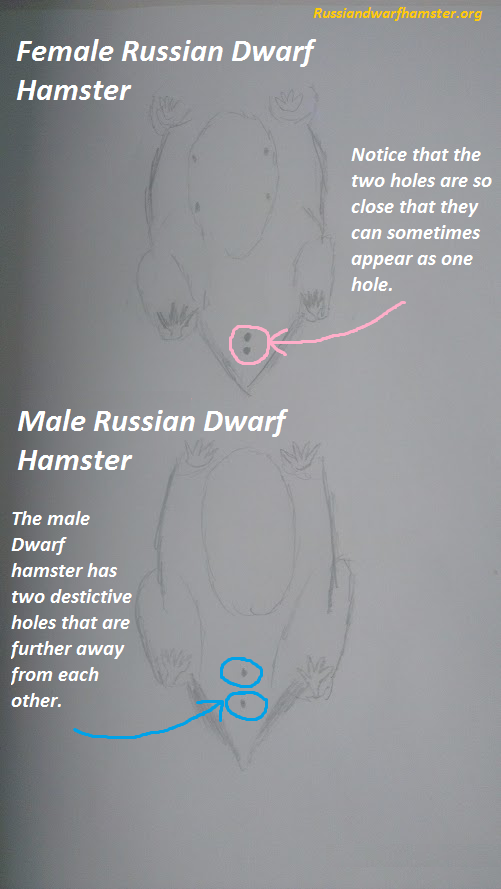
Are Russian dwarf hamsters friendly
Every hamster is friendly when tamed towards humans however Russian dwarfs are more friendly to their same kind than other hamsters including Chinese, Roborovski and Syrian hamsters. In the wild many live together in colonies and many do not. It depends on the hamster and what they prefer. Many Russian dwarfs can live together when brought up with another from a young age.
After about 9+ weeks it becomes harder to introduce two Russian dwarfs together.
Dwarf hamsters compared to Syrian hamsters are easier to tame and handle from an early age however dwarf hamsters can easily become “wild” within a week. Syrian hamsters once tamed are tamed for life. A tamed Russian dwarf is a friendly hamster and will not bite whilst being handled.
Is it Easy to Tame Russian Dwarf Hamsters?
When you know how to tame Russian dwarf hamsters it is easy. Here is how to do it.
This works for both new and older hamsters.
Carefully scoop your hamster up with 2 hands at least once a day. When holding your hamster let them run around your hands and arms (being careful not to drop them). Do this for at least 5 minutes everyday.
After around 1-2 weeks your hamster will be fully tamed and easily picked up. This will also stop them biting you. Regular handling makes taming easy and lets a hamster get used to you. Please see the video on how to handle your hamster here.
Which Gender is Easier to Tame?
Both male and female are easy to tame and none are harder.
Can Russian Hamsters Swim?
Yes, but not for very long. They swim very similar to a dog doing “doggy paddle”. Using their front and back legs in a paddling motion the can travel through water for short periods of time.
Should You Wash Your Hamster?
NO. Russian Dwarfs can easily get hypothermia after being exposed to water around their body. This is because their fur keeps them warm but when wet it becomes very hard to for their body to warm up again.
A sand bath is the solution. You can purchase sand baths at Amazon.com or you can create your own.
Please note that you must use chinchilla sand and not any other type of sand.
Shaking, flipping over, not opening eyes or visual lumps
Any of these can mean a number of things and its best not to predict the future of your hamster before seeing a vet.
Shaking and flipping over can mean your hamster has eaten something to big, there may be a internal problem or something more fatal. It is always advised that you take your hamster to the vet. It may become worse.
Itching & scratching regularly – In the beginning weeks of watching your dwarf hamster you may notice scratching and itching. It is normal for Russian dwarfs to scratch regularly to keep them selves clean. However if marks or cuts appear there is a problem. Here are 3 things that could be causing your hamster to scratch:
- Dust – dust is found in the bedding and in the atmosphere. It can cause hamsters to itch continuously. Get them a sand bath to help keep them self clean.
- Bedding – Change the bedding to something that specifies non irritating for dwarf hamsters. Good brands like Carefresh.
- Sun exposure – The cage should be kept out of suns reach at all times. Cage temperatures easily rise under direct sunlight and this can cause your hamster to itch like mad!
That has been our Russian Dwarf Hamster Facts
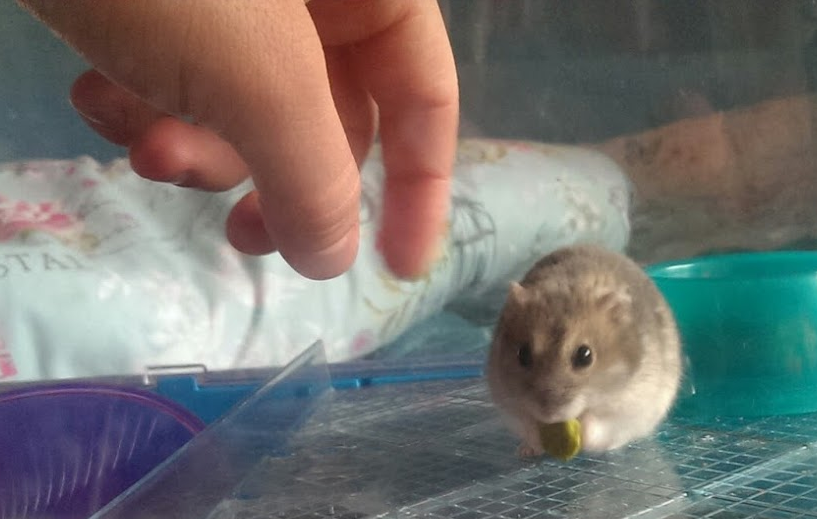
We hope that we have answered most of your questions however if there are some we have missed please leave a comment and we will answer them ASAP.
Have you still got Russian Dwarf Questions? Check these out:


Hi, i got a new black and white russian dwarf hamster yesterday.There was a mean white hamster in the same cage with it at the pet store. The white one constantly would attack my hamster. My hamster WILL NOT stop biting. He is very very very defensive. Would taming it work? Will he always be this defensive with any contact? I’m thinking since the white one was hurting mine, my hamster fears anything that comes near it. Thanks!
Hi congratulations on your new Russian dwarf hamster.
Sounds like you hamster is not friendly with humans yet and has gone through some trauma with the other hamster attacking it constantly. However its not too late…
I recommend you start to tame your new hamster with our 5 steps to success at https://russiandwarfhamster.org/tame-russian-dwarf-hamsters-beginners-guide-to-success/
Follow those steps and let me know how it goes.
Your hamster most probably will be very defensive towards you for the first week but make sure you reassure them as much as you can that you mean no harm. It does sound like it fears a lot after what it has been through.
Hope this helps, you can find more useful guides in our top bar under “care”.
RussianDwarfHamster.Org
Hi, i have been looking at getting a russian dwarf winter white hamster for a while but then i discovered that the min cage size for them is around 80x40cm and my room is too small for that. Do you have any ideas of what i could do. I obviously want the hamster to have enough room.
Hi Alex
Hmm… Good question. Are you allowed to keep it in any other room? Maybe a cage that is 60×40 would be better for you (that also has extra floors.
If you allow your hamster to run around in its ball more than once a day you could just get away with keeping it in a Ferplast duna cage. See our FULL review at https://russiandwarfhamster.org/ferplast-duna-cage-review-dwarf-hamsters/
Hope this helps 🙂
Hi, i think the bigger duna cage is still too big, what are your views on the mini duna
Hi Alex 🙂
We have had the mini duna and the Bigger duna and I can safely say that the mini duna is not a great option.
With the mini duna, your hamster will get bored (talking from experience when I was young), your hamster will find a way to jump up to the top bars and chew/climb all night.
This woke us up every single night more than once and their was nothing we could do. Every hamster owner we know who has had the mini has had the same problem.
Have you considered a bin cage? They are very easy to clean, maintain and about the same size. Check out our video on how to make one at http://www.youtube.com/watch?v=3r7Vcs3z4pI
Hope this helps
RussianDwarfHamster.Org
Ok thankyou, could a young hamster be kept in the ferplast combi 1 if it is played with every couple of hours
Hi Alex
I would personally not recommend that cage for any dwarf hamster. At night they will end up chewing through everything trying to escape. Have you thought about the Duna Cage? You can see our Video Review at https://russiandwarfhamster.org/ferplast-duna-cage-review-dwarf-hamsters/
I recommend that one and you wont have to play with him/her ever couple of hours which will save you a lot of time. Many people recommend the Duna cage, you can see other customer reviews on the link above too.
RussianDwarfHamster.Org
Do i have to cut my Russian dwarf hamsters nails? Its really hard I’ve done it before but shes too fast and jumpy. I’m not sure if its necessary or not. Is it okay if they’re curved or is thst bad?
Hi Newsha 🙂
You do not have to but if it is concerning you, you can take them to a vet to do. We have once trimmed our Russian dwarf hamsters nails using nail trimmers but was very careful. IT is up to you what you choose to do.
Hope this helps
I just came across a cage on the ferplast website called the combi fun (not combi 1) what are your views on it
Hi Alex 🙂
I have recently come across the Combi 1 Fun cage and its is very similar to the Combi. Although has an extra layer. What I recommend to all hamster owners now is buying a plastic see through bin for homeing you hamster in. They are incredibly cheap and spacious!
Deepening on where you live, you can get big bin cages in your local Walmart, Ikea or ASDA for under $13 or £10. Its worth checking out as they are so much easier to clean out and will give your hamster so much space to run around! 🙂
Hope this helps
(p.s thanks for your comment, I will write up a combi Fun cage review this week thanks to your inspiration)
Hi,
I think i will proberly get a bin cage then. Thanks for the advice and i look forward to your review.
No problem Alex. We made a quick video on how to make a bin cage (for instructional purposes) on youtube at http://www.youtube.com/watch?v=3r7Vcs3z4pI
That will give you a good idea of what you will need 🙂
Thanks
Hi im getting a Russian dwarf hamster for Christmas, ive been looking at cages and im getting the ferplast duna cage, my one problem, accessories, I really want the flexible wooden bridge, ive checked amazon and ebay and I cant find anything, could you possibly put a link for it in your reply. Thanks 🙂
sorry, me again, just wondering, my friend had 3 Campbells in the same cage, they each had their own food bowl, house etc… unfortunately they ate each other, could you explain why they did this so if I get another hamster it wont happen.
Thanks. :):)
Hi Oisen 🙂
I am very sorry to hear this. Unfortunately, Russian dwarf hamsters are known to not get along living together unlike pet stores claim. What most likely happened in your case, as they grew older, they began becoming territorial over food, accessories and toys.
To learn more about this, please see https://russiandwarfhamster.org/russian-dwarf-hamsters-fighting/ Russian dwarf hamsters fighting – What to do
Thanks for your comment!!! 🙂
Russiandwarfhamster.org
Hi!
I was just wondering how much play time you would recommend for a dwarf hamster daily.
Depending on how the hamster is feeling and if it is tamed, it can be from 10 mins to 1hr.
Hey! I just got a new Russian dwarf hamster from PetSmart, however, unlike most hamsters, he doesn’t have a black stripe down his back. He’s white, with black on his back. Should I be worried?
Hi!,
No you should not. Russian Dwarfs come in all shapes and sizes. Enjoy your new pet 🙂
Hi, my daughter had 2 brother Russian dwarf hamsters. They were both very friendly and never bit you. One of them died at 11/2 years old. The other one is now nearly 2 years old and has just started biting. We used to pick him up everyday but now when we do pick him up he always bites us. Is thus due to old age? Thanks.
Hi Jenny,
You could be right about the old age.
Sometimes hamsters get a little restless with age, he may also be sad still about loosing his friend. However, do not give up, he is probably afraid or something new may be scaring him.
Another common cause could be boredom, if he is trying to escape a lot, then its time for a new cage or even just a sandbath can help. Check this out https://russiandwarfhamster.org/sand-bath-for-dwarf-hamster/
Hi my granddaughter has a Russian dwarf hamster it’s a lovely pet more usual colour but this week it’s fur is turning whiter it’s only two months old is this normal and it’s not in direct sunlight
Hi Denise,
Sounds like you may have a Winter White Dwarf Hamster – They change colour with the season.
Read more about them here. https://russiandwarfhamster.org/winter-white-hamster-facts/